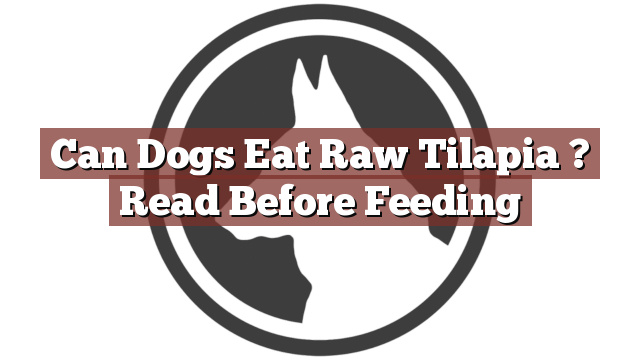Understanding Your Dog’s Dietary Needs
As a responsible pet owner, it is crucial to understand your dog’s dietary needs to ensure their overall health and well-being. Dogs are omnivores, which means they can eat both meat and plants. However, their digestive systems are designed to primarily digest and process animal protein. Unlike humans, dogs lack certain enzymes necessary for breaking down plant-based foods efficiently. Therefore, a balanced diet for a dog should consist mainly of high-quality animal protein.
While it is important to provide your dog with a well-rounded diet, it is equally important to remember that not all human foods are safe for dogs. Some foods can be toxic or cause digestive issues when consumed by our canine companions. It is essential to be aware of what foods are safe and appropriate for dogs, especially when it comes to feeding them raw foods.
Can Dogs Eat Raw Tilapia? Read Before Feeding
Can dogs eat raw tilapia? The answer is yes, dogs can eat raw tilapia. Tilapia is a lean white fish that is a good source of protein and essential nutrients. When prepared and fed correctly, raw tilapia can be a healthy addition to your dog’s diet. However, there are a few important factors to consider before including raw tilapia in your dog’s meals.
Firstly, it is crucial to ensure the quality and freshness of the raw tilapia. Fresh, high-quality fish is less likely to contain harmful bacteria or parasites that could potentially harm your dog. Secondly, it is important to remove all bones from the tilapia before feeding it to your dog. Fish bones can pose a choking hazard and may cause injuries to your dog’s mouth, throat, or digestive tract. Lastly, portion control is crucial. While tilapia is a nutritious protein source, it should be offered in moderation and balanced with other suitable ingredients to provide a complete and balanced diet for your dog.
Pros and Cons of Feeding Raw Tilapia to Dogs
Feeding your dog raw tilapia can have several benefits. Firstly, it is a great source of lean protein, which is essential for building and repairing tissues, supporting healthy muscle development, and maintaining a strong immune system. Additionally, tilapia is rich in omega-3 fatty acids, which promote a healthy coat and skin, reduce inflammation, and support brain function.
However, there are also a few considerations to keep in mind when feeding raw tilapia to your dog. Raw fish, including tilapia, may contain certain parasites or bacteria that can cause foodborne illnesses. It is crucial to handle and store raw fish properly to minimize these risks. Additionally, some dogs may have allergies or sensitivities to fish. If your dog experiences any adverse reactions such as vomiting, diarrhea, or itchiness after consuming raw tilapia, it is best to discontinue feeding it and consult with a veterinarian.
Conclusion: Considerations Before Feeding Raw Tilapia to Your Dog
Feeding raw tilapia to your dog can be a healthy and nutritious addition to their diet if done correctly. However, it is important to remember that each dog is unique, and what works for one may not work for another. Before introducing any new food to your dog’s diet, consult with your veterinarian to ensure it is safe and suitable for your furry friend. Always prioritize the quality, freshness, and proper preparation of any raw food you offer to your dog. By understanding your dog’s specific dietary needs and making informed choices, you can provide them with a balanced and nourishing diet that supports their overall health and vitality.
Thank you for taking the time to read through our exploration of [page_title]. As every dog lover knows, our furry friends have unique dietary needs and responses, often varying from one canine to another. This is why it's paramount to approach any changes in their diet with caution and knowledge.
Before introducing any new treats or making alterations to your dog's diet based on our insights, it's crucial to consult with a veterinarian about [page_title]. Their expertise ensures that the choices you make are well-suited to your particular pet's health and well-being.
Even seemingly harmless foods can sometimes lead to allergic reactions or digestive issues, which is why monitoring your dog after introducing any new food item is essential.
The content provided here on [page_title] is crafted with care, thorough research, and a genuine love for dogs. Nevertheless, it serves as a general guideline and should not be considered a substitute for professional veterinary advice.
Always prioritize the expert insights of your veterinarian, and remember that the health and happiness of your furry companion come first.
May your journey with your pet continue to be filled with joy, love, and safe culinary adventures. Happy reading, and even happier snacking for your canine friend!

